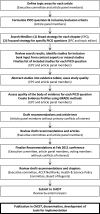Methodology for the development of antithrombotic therapy and prevention of thrombosis guidelines: Antithrombotic Therapy and Prevention of Thrombosis, 9th ed: American College of Chest Physicians Evidence-Based Clinical Practice Guidelines
- PMID: 22315256
- PMCID: PMC3278053
- DOI: 10.1378/chest.11-2288
Methodology for the development of antithrombotic therapy and prevention of thrombosis guidelines: Antithrombotic Therapy and Prevention of Thrombosis, 9th ed: American College of Chest Physicians Evidence-Based Clinical Practice Guidelines
Abstract
Background: To develop the Antithrombotic Therapy and Prevention of Thrombosis, 9th ed: ACCP Evidence-Based Clinical Practice Guidelines (AT9), the American College of Chest Physicians (ACCP) assembled a panel of clinical experts, information scientists, decision scientists, and systematic review and guideline methodologists.
Methods: Clinical areas were designated as articles, and a methodologist without important intellectual or financial conflicts of interest led a panel for each article. Only panel members without significant conflicts of interest participated in making recommendations. Panelists specified the population, intervention and alternative, and outcomes for each clinical question and defined criteria for eligible studies. Panelists and an independent evidence-based practice center executed systematic searches for relevant studies and evaluated the evidence, and where resources and evidence permitted, they created standardized tables that present the quality of the evidence and key results in a transparent fashion.
Results: One or more recommendations relate to each specific clinical question, and each recommendation is clearly linked to the underlying body of evidence. Judgments regarding the quality of evidence and strength of recommendations were based on approaches developed by the Grades of Recommendations, Assessment, Development, and Evaluation Working Group. Panel members constructed scenarios describing relevant health states and rated the disutility associated with these states based on an additional systematic review of evidence regarding patient values and preferences for antithrombotic therapy. These ratings guided value and preference decisions underlying the recommendations. Each topic panel identified questions in which resource allocation issues were particularly important and, for these issues, experts in economic analysis provided additional searches and guidance.
Conclusions: AT9 methodology reflects the current science of evidence-based clinical practice guideline development, with reliance on high-quality systematic reviews, a standardized process for quality assessment of individual studies and the body of evidence, an explicit process for translating the evidence into recommendations, disclosure of financial as well as intellectual conflicts of interest followed by management of disclosed conflicts, and extensive peer review.
Figures


Comment in
-
American College of Chest Physicians guidelines for heparin-induced thrombocytopenia: a need for evidence-based assessment of the baseline risk of heparin-induced thrombocytopenia.Chest. 2013 Apr;143(4):1190-1191. doi: 10.1378/chest.12-2926. Chest. 2013. PMID: 23546508 No abstract available.
-
Response to Dr Junqueira.Chest. 2013 Apr;143(4):1191. doi: 10.1378/chest.13-0035. Chest. 2013. PMID: 23546509 No abstract available.
References
-
- Hirsh J, Guyatt G, Albers GW, Harrington R, Schünemann HJ. American College of Chest Physicians Antithrombotic and thrombolytic therapy: American College of Chest Physicians Evidence-Based Clinical Practice Guidelines (8th Edition) Chest. 2008;133(suppl 6):110S–112S. - PubMed
-
- Guyatt GH, Eikelboom JW, Gould MK, et al. Approach to outcome measurement in the prevention of thrombosis in surgical and medical patients: antithrombotic therapy and prevention of thrombosis, 9th ed: American College of Chest Physicians evidence-based clinical practice guidelines. Chest. 2012;141(2) suppl:e185S–e194S. - PMC - PubMed
-
- Guyatt G, Montori V, Devereaux PJ, Schünemann H, Bhandari M. Patients at the center: in our practice, and in our use of language. ACP J Club. 2004;140(1):A11–A12. - PubMed
MeSH terms
Substances
Grants and funding
LinkOut - more resources
Full Text Sources
Medical

